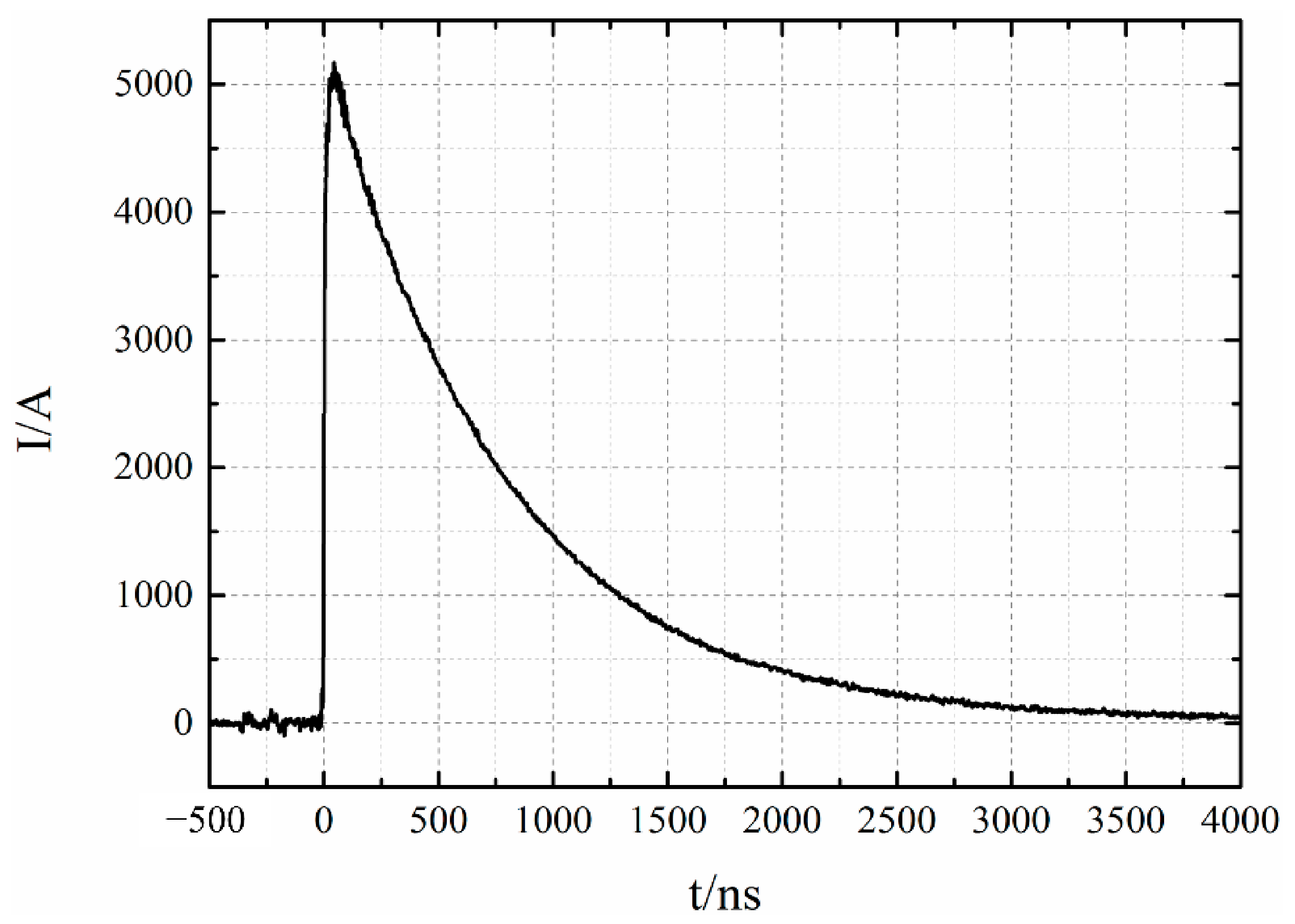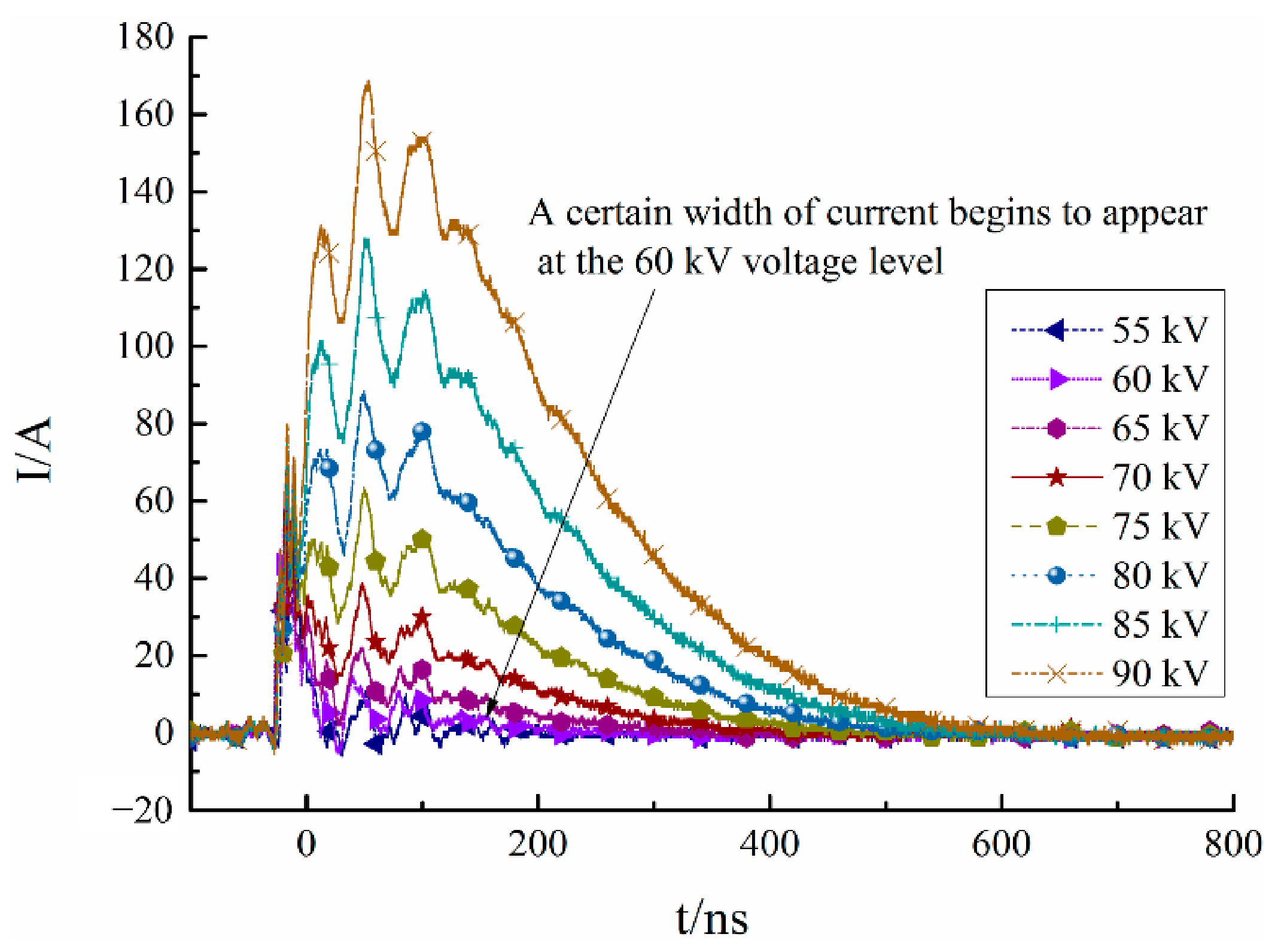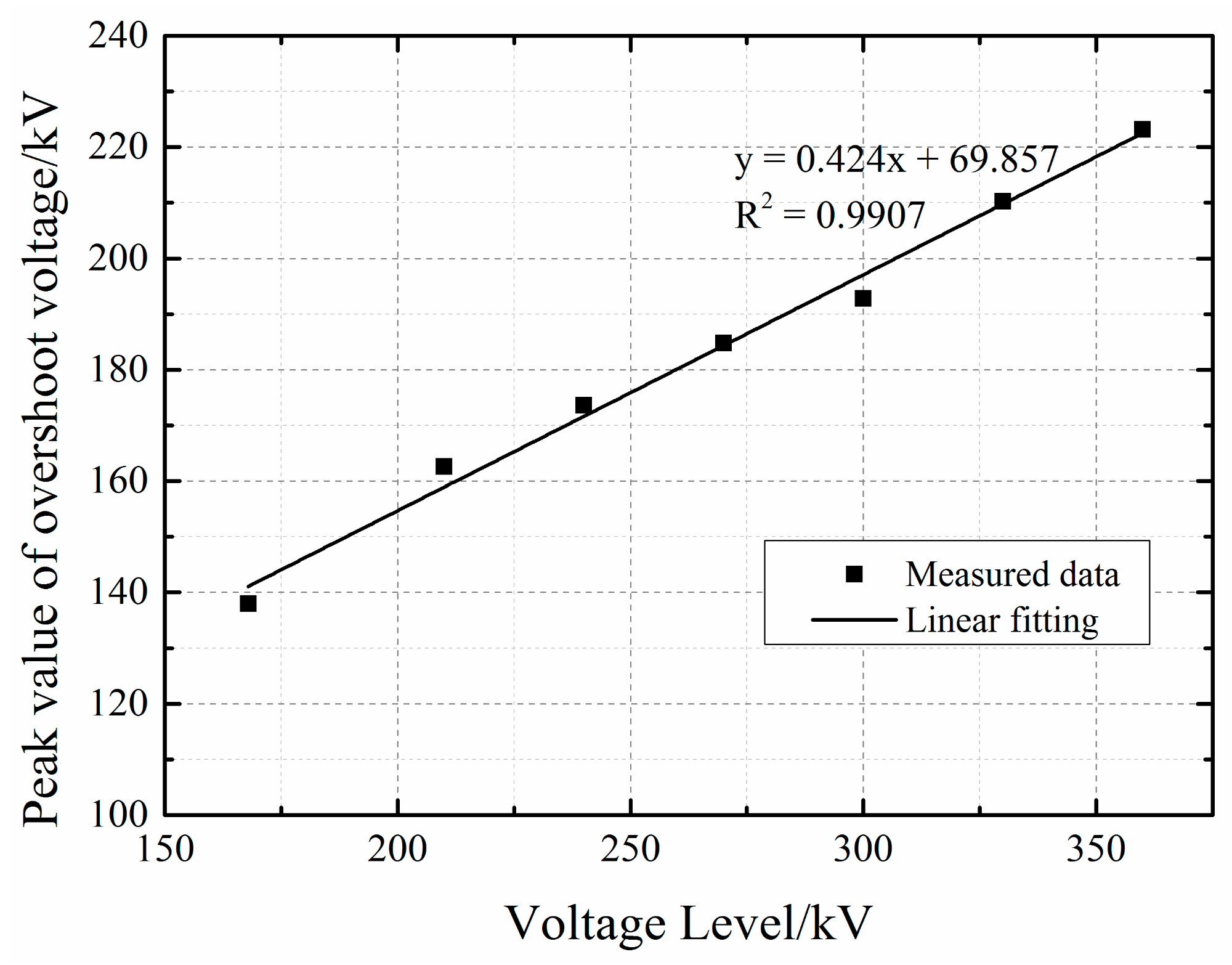Transient Response Characteristics of Metal Oxide Arrester under High-Altitude Electromagnetic Pulse
Abstract
:1. Introduction
2. Experimental Setting
2.1. Experimental Device
2.2. Metal Oxide Arrester
3. Experimental Process and Key Parameter Measurement
3.1. Experimental Process
3.2. Key Parameter Measurements
4. Results and Discussion
4.1. Action Voltage
4.2. Peak Value of Overshoot Voltage
4.3. Peak Value of Residual Voltage
4.4. Response Time
5. Conclusions
- (a)
- In the high-altitude electromagnetic pulse conduction environment, the action voltage of this type of arrester was about 60 kV, which was 3.53 times its rated working voltage. In other words, a strong electromagnetic pulse with an amplitude below 60 kV could be applied to the power equipment at the back end of the arrester completely without restraint, posing a risk to the insulation of the power equipment.
- (b)
- The peak value of overshoot voltage was 2.20 times higher than the residual voltage under the 8/20 μs lightning shock current. Moreover, it was linear with the pulse current, which meant an approx. 10 kV/ns pulse voltage under the 5 kA HEMP conduction current. It poses a greater threat to the insulation of transformers behind the arrester.
- (c)
- The peak value of residual voltage was 1.57 times higher than the residual voltage under the 8/20 μs lightning shock current. In addition, it was linear with the pulse current amplitude, which meant an above-100 kV residual voltage under the 5 kA HEMP conduction current. Moreover, it took more than ten microseconds for the voltage to decay to zero, which may cause the burning of weak links such as cables and transformer bushings.
- (d)
- The response time did not vary with the pulse current amplitude, with an average of 46.86 nanoseconds under the HEMP conduction environment. That meant that the response of this type of arrester to high-altitude electromagnetic pulses is not fast enough, such that the rising edge and peak parts will all leak to the back end of the arrester, exerting an adverse impact on the downstream equipment.
Author Contributions
Funding
Institutional Review Board Statement
Informed Consent Statement
Data Availability Statement
Conflicts of Interest
References
- Mao, C.; Cheng, Y.; Xie, Y. High Altitude Electromagnetic Pulse Technology Foundation; Science Press: Beijing, China, 2019. (In Chinese) [Google Scholar]
- IEC61000-2-10; Electromagnetic Compatibility (EMC)—Part 2-10: Environment—Description of HEMP Environment—Conducted Disturbance; IEC: Geneva, Switzerland, 1998.
- Hoad, R.; Radasky, W.A. Progress in High-Altitude Electromagnetic Pulse (HEMP) Standardization. IEEE Trans. Electromagn. Compat. 2013, 55, 532–538. [Google Scholar] [CrossRef]
- Xie, H.; Du, T.; Zhang, M.; Li, Y.; Qiao, H.; Yang, J.; Shi, Y.; Wang, J. Theoretical and Experimental Study of Effective Coupling Length for Transmission Lines Illuminated by HEMP. IEEE Trans. Electromagn. Compat. 2015, 57, 1529–1538. [Google Scholar] [CrossRef]
- Zhang, H.; Zou, J.; Tian, B.; Tian, M. Flashover Possibility Analysis of Overhead Power Transmission and Distribution Line Insulators with the Excitation of High Altitude Electromagnetic Pulse. Trans. China Electrotech. Soc. 2020, 35, 435–443. (In Chinese) [Google Scholar]
- Xie, Y.; Liu, M.; Chen, Y. Electromagnetic Resilience of Critical National Onfrastructure. High Power Laser Part. Beams 2019, 31, 070001–1-8. (In Chinese) [Google Scholar]
- Chen, Y.; Xie, Y.; Liu, M.; Gao, C.; Li, M.; Gong, S.; Zhou, J. Analysis of High-Altitude Electromagnetic Effect Models on Power System. High Power Laser Part. Beams 2019, 31, 070007–1-6. (In Chinese) [Google Scholar]
- Kozlov, A.; Parfenov, Y.; Chepelev, V.; Shurupov, A.; Shurupov, M.; Chen, Y.; Xie, Y. Assessing Immunity of Power Systems to Effects of High-Voltage Pulses with Power On. High Power Laser Part. Beams 2019, 31, 070006. [Google Scholar]
- Xiong, T. Electric Arresters; China Water & Power Press: Beijing, China, 2013. (In Chinese) [Google Scholar]
- Martinez, J.A.; Durbak, D.W. Parameter Determination for Modeling Systems Transients—Part V: Surge Arresters. IEEE Trans. Power Deliv. 2005, 20, 2073–2078. [Google Scholar] [CrossRef]
- Karbalaye Zadeh, M.; Abniki, H.; Shayegani Akmal, A.A. The Modeling of Metal-Oxide Surge Arrester Applied to Improve Surge Protection. In Proceedings of the 2nd International Conference on Power Electronics and Intelligent Transportation System, Shenzhen, China, 19–20 December 2009; pp. 238–243. [Google Scholar]
- Wu, S.; Xiang, X.; Li. H. A Modified Model for Metal-oxide Surge Arrester and Its Parameter Identification. Insul. Surge Arresters 2009, 232, 26–30. (In Chinese) [Google Scholar]
- Tai, X.; Li, R.; Xia, J. Influence of Model of Surge Arrester Makes on VFTO Simulation. Northeast. Electr. Power Technol. 2013, 10, 6–11. (In Chinese) [Google Scholar]
- He, J.; Tu, Y. Equivalent Calculation Model of Non-linear Resistance of Zinc Oxide. High Volt. Appar. 1998, 6, 50–54. (In Chinese) [Google Scholar]
- Zhong, X.; Zhou, L.; Zhao, X.; Deng, H.; Liu, T.; Peng, J. Study on Surge Arrester Model in the Simulation and Calculation of VFTO. Electr. Power Sci. Eng. 2014, 30, 73–77. (In Chinese) [Google Scholar]
- Chen, J.; Guo, J.; Wang, L.; Dai, M.; Jiao, L.; Cui, L. The V-A Characteristics under Steep-front Waves of Metal Oxide Surge Arrester Model. Insul. Surge Arresters 2013, 4, 68–74. (In Chinese) [Google Scholar]
- Li, Z.; Yan, X.; Wang, H.; He, Z.; Li, X.; Song, J. Analysis of Test and Model for Metal Oxide Arrester under Steep-Front Wave. High Volt. Eng. 2012, 38, 2698–2706. (In Chinese) [Google Scholar]
- Valsalal, P.; Udayakumar, K. Importance of Capacitance on Metal Oxide Arrester Block Model for VFTO Applications. IEEE Trans. Power Deliv. 2011, 26, 1294–1295. [Google Scholar] [CrossRef]
- Zhang, J.; Jiang, Y.; Zhang, Y.; Li, Y.; Huang, L.; Liu, F. Nanosecond Pulse Response of Typical Voltage-clamping Surge Protective Devices. High Power Laser Part. Beams 2016, 28, 125003. (In Chinese) [Google Scholar]
- Zhou, Y.; Xie, Y.; Zhang, D.; Dong, N.; Chen, Y.; Jing, Y. Response of 10-kV Metal-Oxide Surge Arresters Excited by Nanosecond-Level Transient Electromagnetic Disturbances. IEEE Trans. Electromagn. Compat. 2021, 63, 614–621. [Google Scholar] [CrossRef]
- Brito, V.S.; Lira, G.R.S.; Costa, E.G.; Maia, M.J.A. A Wide-Range Model for Metal-Oxide Surge Arrester. IEEE Trans. Power Deliv. 2018, 33, 102–109. [Google Scholar] [CrossRef]
- Bowman, T.; Halligan, M.; Llanes, R. High-Frequency Metal-Oxide Varistor Modeling Response to Early-time Electromagnetic Pulses. In Proceedings of the IEEE International Symposium on Electromagnetic Compatibility & Signal/Power Integrity (EMCSI), Reno, NV, USA, 28 July–28 August 2020. [Google Scholar]
- Cui, Z.; Mao, C.; Sun, B. SPICE Modeling of Pulsed Current Injection with Inductive Coupling. Acta Electron. Sin. 2017, 45, 1513–1517. (In Chinese) [Google Scholar]
- GB11032-2010; Metal Oxide Surge Arresters without Gaps for A.C. Systems. AQSIQ; SAC: Beijing, China, 2011. (In Chinese)








| Type | Rated Voltage/kV | Residual Voltage of 8/20 Lightning Shock Current/kV | Residual Voltage 30/60 Operation Impact Current/kV | DC 1 mA Reference Voltage/kV |
|---|---|---|---|---|
| Y(H)5WS-17(12.7)/50 | 17(12.7) | 50.0 | 42.5 | 25.0 |
| Voltage Level/kV | 168 | 210 | 240 | 270 | 300 | 330 | 360 |
| Overshoot Peak Value/kV | 138.0 | 162.6 | 173.6 | 184.8 | 192.8 | 210.3 | 223.2 |
| Voltage Level/kV | 168 | 210 | 240 | 270 | 300 | 330 | 360 |
| Residual Peak Value/kV | 85.5 | 92.6 | 103.2 | 105.9 | 103.7 | 106.9 | 113.9 |
| Voltage Level/kV | 168 | 210 | 240 | 270 | 300 | 330 | 360 |
| Average Response Time/ns | 50.8 | 47.9 | 48.5 | 48.3 | 45.3 | 44.1 | 43.1 |
Publisher’s Note: MDPI stays neutral with regard to jurisdictional claims in published maps and institutional affiliations. |
© 2022 by the authors. Licensee MDPI, Basel, Switzerland. This article is an open access article distributed under the terms and conditions of the Creative Commons Attribution (CC BY) license (https://creativecommons.org/licenses/by/4.0/).
Share and Cite
Qin, F.; Chen, W.; Wang, X.; Huang, T.; Cui, Z.; Nie, X. Transient Response Characteristics of Metal Oxide Arrester under High-Altitude Electromagnetic Pulse. Energies 2022, 15, 3303. https://doi.org/10.3390/en15093303
Qin F, Chen W, Wang X, Huang T, Cui Z, Nie X. Transient Response Characteristics of Metal Oxide Arrester under High-Altitude Electromagnetic Pulse. Energies. 2022; 15(9):3303. https://doi.org/10.3390/en15093303
Chicago/Turabian StyleQin, Feng, Wei Chen, Xutong Wang, Tao Huang, Zhitong Cui, and Xin Nie. 2022. "Transient Response Characteristics of Metal Oxide Arrester under High-Altitude Electromagnetic Pulse" Energies 15, no. 9: 3303. https://doi.org/10.3390/en15093303
APA StyleQin, F., Chen, W., Wang, X., Huang, T., Cui, Z., & Nie, X. (2022). Transient Response Characteristics of Metal Oxide Arrester under High-Altitude Electromagnetic Pulse. Energies, 15(9), 3303. https://doi.org/10.3390/en15093303







